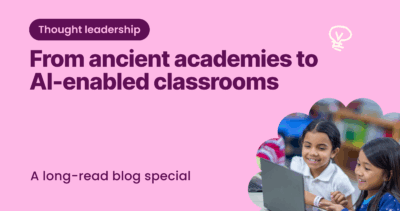
Shirin Bradfield
You’ve read what ChatGPT is, how to use it in the classroom, and whether you should be concerned about academic cheating. You’ve come this far, why not stick around for one last blog? Five minutes now could save hours in the future.
We want to help you get the most out of your hours, so you can spend less time typing and more time teaching!
As a teacher, managing your time effectively in the classroom can be a challenge. With so many plates to spin, from lesson planning to grading assignments, it can be difficult to find time for everything. Since you’ve read all about it, and are now experts in chatbot etiquette, why not try out its amazing processing power to save time this school year?
ChatGPT can be a valuable tool to help teachers like you make the most of their time in the classroom. Here are Kami’s top ten tips to use ChatGPT for time management!
- Get new ideas fast: Input keywords or topics into ChatGPT to generate a list of resources and ideas for lesson plans or classroom activities. Typing in “Ten creative writing prompts,” or something similar can help you save time searching for new ideas and keep your lessons fresh and engaging.
- Create a classroom FAQ list: Use ChatGPT to create a list of frequently asked questions and their answers for students. You can print it off and stick it to the wall. This is especially useful if you have a high turnover of students.
- Customize assignments for each student: ChatGPT can help teachers facilitate personalized learning by analyzing student data and creating customized assignments and activities that cater to each student’s strengths and weaknesses. You can create thirty unique, but structurally similar assignments in only a couple of minutes!
- Enhance classroom engagement: Use ChatGPT to generate questions or discussion topics related to the day’s lesson, and have students respond to them in real-time during class. This can encourage active participation and critical thinking, as well as facilitate discussions and collaboration among students. Additionally, teachers can use ChatGPT to generate quizzes or games to review material and reinforce learning objectives.
- Enhance teaching variety: ChatGPT can help teachers discover new and creative ways to teach by suggesting different teaching methods, activities, or projects that can be used in the classroom. For example, if prompted with “how can I improve teaching variety in my fifth-grade math class”, ChatGPT could suggest using real-world examples to show students how math is used in everyday life, such as calculating taxes or measuring ingredients for a recipe. This can help keep students engaged and save time by reducing the need for teachers to come up with new ideas on their own.
- Impossible imaginings: Use ChatGPT to devise something completely new, such as a new flavour of icecream or a new colour. Once ChatGPT has described it, have your students either discuss or write their own interpretation of ChatGPT’s creations. Attempting to draw a new colour could be interesting!
- Automate grading: Team up with ChatGPT for simple tasks such as checking for spelling and grammar errors. Paste in the piece of text and you can ask ChatGPT to point out all the errors. This will free up more time for you to focus on other important tasks, such as providing feedback to students.
Although ChatGPT can be a useful tool for teachers, it’s not a one-size-fits-all solution. It’s up to each teacher to decide if and how they want to use ChatGPT in their specific classroom. While the tool can help with time management and personalizing learning experiences, it’s not a substitute for building relationships with students and inspiring them to reach their full potential. By carefully incorporating ChatGPT into their teaching routine, teachers can streamline their workload and save time, allowing them to focus more on what matters most: their students.
It’s also important to note that ChatGPT keeps a record of everything you type into it and its privacy policy does state that it may collect personal information from your messages and any files you upload. So be careful with what information you give it and avoid typing in any personal or confidential information. It’s always best to check your school or district’s policy as well.
Let’s make this school year the most productive one yet!
You may also like

From ancient academies to AI-enabled classrooms

Improving AI literacy in American schools

